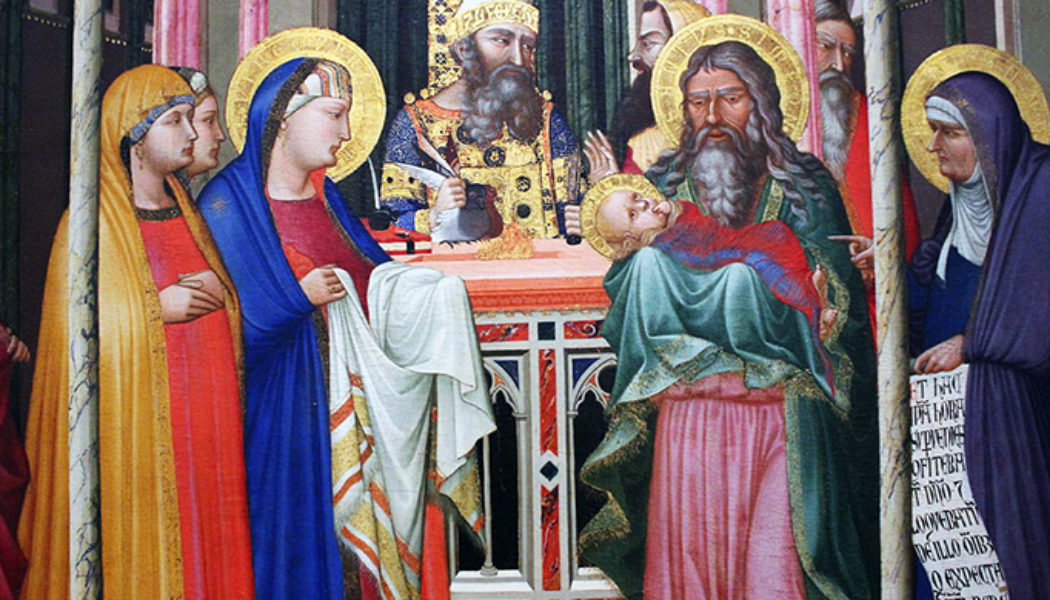
Feb. 2 is the Feast of the the Presentation of the Lord.
We read about the presentation of the Lord in Luke Chapter 2, but the text can be a little mysterious.
What is actually happening there?
Some claim that Luke himself didn’t know…
What Luke Says
Here is what Luke (2:22-24) actually says about the event:
And when the time came for their purification according to the law of Moses, they brought him up to Jerusalem to present him to the Lord (as it is written in the law of the Lord, ’Every male that opens the womb shall be called holy to the Lord’) and to offer a sacrifice according to what is said in the law of the Lord, ‘a pair of turtledoves, or two young pigeons.’
He then records the encounters with Simeon and Anna the prophetess, but at the moment our focus is what Luke refers to as “their purification.”
What is he talking about?
The Purification of the Mother
The first thing to note is that Luke is not talking about the time of Jesus’ circumcision. That occurred on the eighth day after his birth. Luke has already talked about that and is now referring to a later time.
Specifically, he’s talking about the 40th day after Christ’s birth.
We know that because of he quotes from Leviticus 12:8 (“a pair of turtledoves, or two young pigeons”), which refers to the purification ritual that a Jewish mother needed to perform to become ritually clean again after childbirth.
In the case of a boy, this was on the 40th day after childbirth (which is why this feast is on Feb. 2 — 40 days after Christmas, counting Dec. 25 as the first day).
In the case of a girl child, the purification was later.
This leads to a question …
Why “Their” Purification?
Leviticus only mentions the purification of the mother, not anybody else. So why does Luke refer to the time of “their” purification?
Some have thought Luke was fuzzy on how all this was supposed to work.
That seems unlikely to me. Luke may have been a Gentile Christian, but he was living amidst numerous Jewish Christians, and in keeping with his habit of investigating things thoroughly, he would have been able to find out precisely how these things worked.
I think another explanation is more likely, and there are several possible ones.
One is that Luke is just speaking in a general way. The rite of purification was something that the whole family was present for. They all made the journey to the temple together, and so it was in some sense “their” effort, even if it was Mary in particular who was being ritually purified.
If a modern family goes to a restaurant to celebrate the birthday of one of it’s members, it is in one sense “their” party, even if in another sense it is the party of the one having the birthday.
In the same way, if the whole family goes to the temple for a purification, Luke can speak of it as “their” purification, even if they aren’t all being purified.
A Poor But Obedient Family
There are a couple more things to note about Mary’s purification.
The first is that the offering she made indicates that the Holy Family was poor. The ordinary offering was a lamb and a dove, but in cases where a family was too poor for that, two doves were used instead.
Despite its noble lineage, belonging to the line of David, Joseph’s family had fallen on hard times and was among the poor.
They were still obedient to what the Law of Moses required, though. This is the reason why Mary offers the second dove as “a sin offering” (see Leviticus 12:6), though she herself was immaculate.
This act does not indicate that she was a sinner any more than Jesus’ circumcision, baptism, or participation in other sacrificial rites indicates that he was a sinner.
And there is more happening here …
The Redemption of the Firstborn
Luke also quotes Exodus 13:2, which deals with the redemption of firstborn males.
The idea behind this ritual was that every male firstborn — whether human or animal — is holy to God, the same way that the firstfruits of a crop were holy to God.
Consequently, they had to either be given to God in sacrifice or redeemed — bought back from him.
Since human sacrifice was illegal and immoral, all firstborn boys had to be redeemed, which was done by their father paying a priest five shekels.
Luke Confused Again?
Again, people accuse Luke of being confused about this. It is argued that the redemption of the firstborn didn’t take place at the Temple, and so there was no reason for the Holy Family to bring Jesus there.
Again, the criticism is misplaced.
While it may have been possible for a boy to be redeemed anywhere, it was natural for this to be done at the temple, and we know — in fact — that there was a tradition of doing so.
We read about that in Nehemiah 10:35-36, where the people took an oath, saying:
We obligate ourselves … to bring to the house of our God, to the priests who minister in the house of our God, the firstborn of our sons and of our cattle, as it is written in the law.
No Mention of Redemption?
Interestingly, Luke does not mention Joseph paying the five shekels to a priest. Why not?
It could be that he simply takes this act for granted, just as he doesn’t go into the details of the rite of Mary’s purification. He has cited the Old Testament passages referring to these rites, and he takes that as sufficient indication they were performed.
But some have thought there may be a deeper significance to his failing to mention Jesus being redeemed.
Why might that be?
Still Consecrated
The obvious answer would be that Jesus was considered as still consecrated to the Lord.
Two reasons suggest themselves. First, as the Jewish Encyclopedia notes:
Not only priests and Levites, but also Israelites whose wives are the daughters of priests or Levites, need not redeem their firstborn.
Joseph was the husband of Mary, and Mary was a relative of Elizabeth, who was “of the daughters of Aaron” (Luke 1:5), so perhaps Mary’s lineage didn’t require her to have her Son redeemed.
In that case, he was presented at the Temple in acknowledgement of his consecration to God.
Or, if the redemption was done, Luke may meant to suggest, on a literary level, that Jesus remained totally consecrated to God.
Benedict XVI comments:
Evidently Luke intends to say that instead of being ‘redeemed’ and restored to his parents, this child was personally handed over to God in the Temple, given over completely to God. … Luke has nothing to say regarding the act of ‘redemption’ prescribed by the law. In its place we find the exact opposite: the child is handed over to God, and from now on belongs to him completely. (Jesus of Nazareth: The Infancy Narratives: 3)
This article originally appeared Feb. 2, 2014, at the Register.








